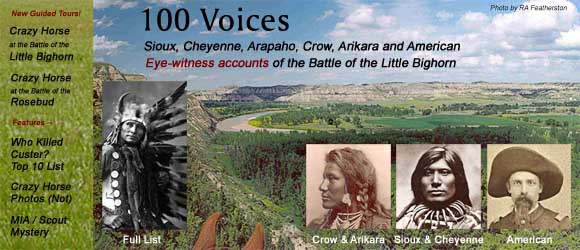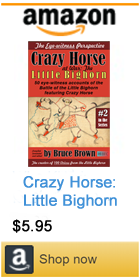|
||||||||||||
Bruce Brown's 100 Voices... Horned Horse's Story of the Battle
The Little Big Horn is a stream filled with dangerous quicksand, and cuts off the edges of the northern bluffs sharply near the point where Custer perished. The Indians first saw the troops on the bluffs early in the morning, but, owing to the abruptness and height of the river banks, Custer could not get down to the edge of the stream. The valley of the Little Big Horn is from half a mile to a mile and a half wide, and along it for a distance of fully five miles the mighty Indian village stretched. Most of the immense pony herd was out grazing when the savages took the alarm at the appearance of the troops on the heights. The warriors ran at once for their arms, but by the time they had taken up their guns and ammunition belts, the soldiers had disappeared. The Indians thought they had been frightened off by the evident strength of the village, but again, after what seemed quite a long interval, the head of Custer's column showed itself coming down a dry watercourse, which formed a narrow ravine, toward the river's edge. He made a dash to get across, but was met by such a tremendous fire from the repeating rifles of the savages that the head of his command reeled back toward the bluffs after losing several men who tumbled into the water, which was there but eighteen inches deep, and were swallowed up in the quicksand. This is considered an explanation of the disappearance of Lieutenant Harrington and several men whose bodies were not found on the field of battle. They were not made prisoners by the Indians, nor did any of them succeed in breaking through the thick array of infuriated savages. [Note: This is a novel theory concerning the quicksand at Medicine Tail Coulee and the complete disappearance of some of the fallen Seventh Cavalry troopers. Horned Horse's supposition that Custer's men were turned back by large numbers of Indian defenders at Medicine Tail Coulee is contradicted by White Shield, He Dog and others. More likely, Custer's charge was repulsed by the one shot from one defender, White Cow Bull, who described shooting a man who can only be Custer off his horse and watching the man fall in the river, which brought all the other cavalry troopers to an immediate halt. See Who killed Custer -- The Eye-witness Answer for more info.] Horned Horse did not recognize Custer, but supposed he was the officer who led the column that attempted to cross the stream. Custer then sought to lead his men up to the bluffs by a diagonal movement, all of them having dismounted, and firing, whenever they could, over the backs of their horses at the Indians, who by that time had crossed the river in thousands, mostly on foot, and had taken the General in flank and rear, while others annoyed him by a galling fire from across the river. Hemmed in on all sides, the troops fought steadily, but the fire of the enemy was so close and rapid that they melted like snow before it, and fell dead among their horses in heaps. He could not tell how long the fight lasted, but it took considerable time to kill all the soldiers. The firing was continued until the last man of Custer's command was dead. Several other bodies besides that of Custer remained unscalped, because the warriors had grown weary of the slaughter. The watercourse, in which most of the soldiers died, ran with blood. He had seen many massacres, but nothing to equal that. If the troops had not been encumbered by their horses, which plunged, reared, and kicked under the appalling fire of the Sioux, they might have done better. As it was, a great number of Indians fell, the soldiers using their revolvers at close range with deadly effect. More Indians died by the pistol than by the carbine. The latter weapon was always faulty. It "leaded" easily and the cartridge shells stuck in the breech the moment it became heated, owing to some defect in the ejector.... Warpath and Bivouac: The Bighorn and Yellowstone Expedition, by John F. Finerty, Lakeside Press, Chicago, IL, 1955 p 208 - 211
Another son of Horned Horse, White Cow Walking, survived the battle. Horned Horse served as Crazy Horse's emisary at Fort Robinson in 1877 after Crazy Horse's surrender. For more information on Crazy Horse's surrender, please see the Crazy Horse Surrender Ledger.
|
||||||||||||




 HORNED HORSE, an old Sioux chief, whose son [White Eagle] was killed early in the fight, stated to the late Capt. [William] Philo Clark, after the surrender of the hostiles, that he went up on a hill overlooking the field to mourn for the dead, as he was too weak to fight, after the Indian fashion. He had a full view of all that took place almost from the beginning.
HORNED HORSE, an old Sioux chief, whose son [White Eagle] was killed early in the fight, stated to the late Capt. [William] Philo Clark, after the surrender of the hostiles, that he went up on a hill overlooking the field to mourn for the dead, as he was too weak to fight, after the Indian fashion. He had a full view of all that took place almost from the beginning.







